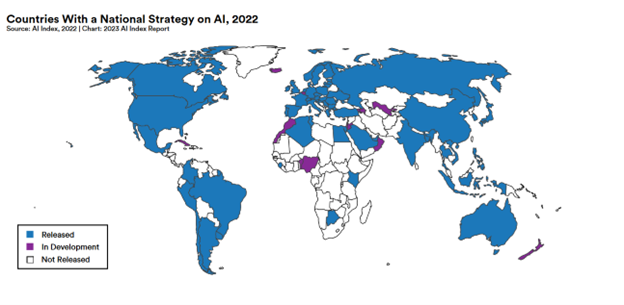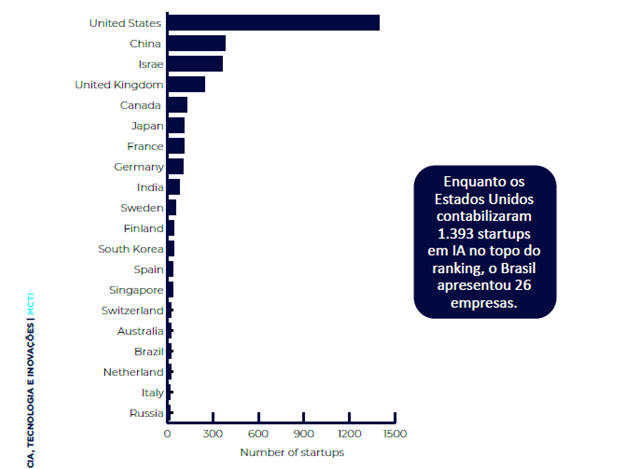Different regimes of technosolutionism: AI and the development/underdevelopment dilemma in Brazil
Guilherme Cavalcante Silva08/21/2023 | Reflections
Since Canada released the first national Artificial Intelligence (AI) strategy in 2017, what has been referred to as a “regulatory race” (Smuha, 2021) for AI has gained traction. Over 60 national strategies have been released and almost 40 AI-related bills have been enacted until the end of 2022. But if you never had heard about AI before you would certainly have a lot of trouble reading these documents and trying to understand what they were referring to. Sensational pictures of the potentials that AI can bring in fill pages and pages of policy documents, however descriptions of what AI in fact is or why is it needed are meagre. In the case of the Brazilian Strategy of AI, for instance, there is a quick mention to OECD’s definition of AI, while a total of 34 paragraphs mention what AI could bring to promote scientific advances and fight social inequalities.

Figure 1 - By the end of 2022, over 60 countries around the world have released a national AI strategy, according to Stanford's AI Index Report. Source: AI Index 2023.
These hyperbolic tales of technological fixes are not new to AI. In fact, several scholars have tried to name this phenomenon. Nowadays, terms such as “technocracy” (Kitchin et al, 2019), “pro-tech innovation bias” (Godin and Vinck, 2017), and “technological solutionism” (Polonski, 2018) are popular within critical scholars to name this “endemic ideology that recasts complex social phenomena as neatly defined problems with definite, computable solutions —if only the right algorithms are in place!” (Morozov, 2013). These hyped discourses and promises are more than just wishful thinking. They define categories (e.g. guide the focus of AI discussions on ‘autonomy’ or ‘consciousness’ or ‘economic competitiveness’ instead of data collection or monopoly) and delineate which problems should receive attention and those who should not (Bareis and Katzenbach 2022). Are these tech solutionists imperatives the same everywhere, however? Would we find the same tech solutionist imperatives in Brazilian AI policy discussions as compared to other nations? Is this “race to AI regulation” driven by the same imperatives? Could we even talk about the same “race” towards the same “goal”?
In the Brazilian case, the AI strategy was officially released by the Ministry of Science, Technology, and Innovation of Brazil (MCTIC) in 2021, after two years of public consultations. The document is part of a recent package of data-related legislations, such as the General Data Protection Law (LGDP in Portuguese) in 2019 and the program IA² (2020). Another major AI policy development in the country was the release of the first Call for Applied Research Centres in Artificial Intelligence by the São Paulo Research Foundation (Fapesp) in partnership with MCTIC and the Brazilian Internet Steering Committee (CGI.br) in 2019.
Both policy moves reproduce the generic and vague nature of technology policies from all over the world. The Brazilian strategy, for instance, makes no mention of investments, funding, or any concrete initiative. When money is mentioned, as is the case of the call for AI research centres, it is barely enough to afford scholarships, severely hindering the institutes’ capacity to develop infrastructure while increasing their dependency on private investments, especially from global corporations (Silva, 2022).
Still, it is interesting to notice how they reproduce an association between AI development and the future of Brazil. Several charts and visual aids highlight the country’s distance to the Western world in almost every single scenario, including economic situation and openness to business, a feature particularly prevalent in the Brazilian strategy as compared to the ones from countries such as India and Mexico, which gave preference to internal data on their strategies and comparison with other so-called emergent nations. These comparative data are not further explained in the document, serving as a self-explanatory description of the need to boost investments in AI. The origins or causes of the problems barely matter in the document as much as the status of the country – investing in AI becomes a way of overcoming backwardness, a way of catching up, of rising to the next level along with the leading actors of the world.

Figure 2 - Strategy is full of visual data showing the country lagging behind 'industrially advanced' nations. Graphic states [in Portuguese]: “While the US had 1393 AI startups at the top of the ranking, Brazil only had 26 companies." Source: Brazilian Strategy of AI.
The first AI policy documents in Brazil are surrounded by an image of backwardness and dependency, perpetuating an image of a country that is fundamentally dependent and underdeveloped, “a mere consumer of high tech and follower of trends from the advanced nations” (Silva, 2022). The question of development and underdevelopment has been a key issue throughout the history of Latin American Science, Technology & Policy thinking and practice. One of the most influential concepts in Latin American technology policy historically was the idea that copying and mimicking science and technology frameworks from Western nations, or the adoption of so-called ‘best practices’, would booster development (e.g. Sábato, 1975). The role of international organizations such as OECD has been pointed out as key to perpetuating this idea.
However, few considerations have been made about the very idea of development and underdevelopment. Brazilian sociologist Francisco de Oliveira considered this to be a sin caused by the “acritical appropriation of Anglo-Saxon literature on development”, treating “opulence and misery as two isolated poles” (Oliveira, 1973) whose existence is not interdependent.
When moving the discussion on technological solutionism and technology hype away from the Silicon Valley and the US and EU legislative contexts, STS scholars need to navigate through a much-neglected arena: the one of the very socially constituted notion of development and underdevelopment. Although the asymmetry between Western nations and peripheral countries in several socioeconomic and political aspects is evident, development and underdevelopment need to be addressed as sociohistorical articulations that enact particular visions of what a country is and could be. After all, in an era of expanding global crises, what exactly we are aspiring to “catch-up” with? How can we bring once again the question of the very meaning of development and underdevelopment to the centre of tech policy discourse?
Guilherme Cavalcante Silva is a PhD Student in Science and Technology Studies at York University, Canada and Assistant Editor of Backchannels, the blog of the Society for Social Studies of Science (4S). Guilherme is interested in knowledge production, sociology of expectations, and science policy in the Global South.
Published: 08/21/2023
